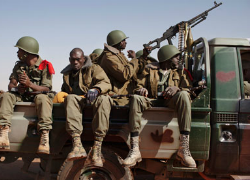
In early 2012, fighting broke out in northern Mali after a coup by army officers in the capital of Bamako. Shortly thereafter, Tuareg fighters and other armed groups advanced on towns, which fell to their control in a broad triangular area in the northern Mali desert. The Tuareg are a traditionally nomadic people who are also the principal inhabitants of the North Africa Saharan desert interior. The Tuareg rebels refer to the broad triangular area in northern Mali’s desert as Azawad. The Tuareg rebels have proclaimed that the Azawad area is independent.
By May 2012, the Tuareg rebels had joined with Islamist forces not only to seize northern Mali but also to agree to merge and turn the new territory into an Islamist state. The Tuareg National Movement for the Liberation of Azawad (MNLA) signed a deal with an Islamist group with ties to al-Qaeda, Ansar Dine, in the town of Gao. By that time Ansar Dine had already begun to impose Sharia law in towns within its new borders, such as Timbuktu.
Fast forward to February 2013, and the deal signed between Tuareg MNLA rebels and Ansar Dine has collapsed. Ansar Dine was joined and backed by the Movement for Oneness and Jihad in West Africa (MUJAO), pushing the Tuareg rebels aside, and leading to the collapse of the agreement. While some MNLA fighters joined the Islamist groups, the MNLA came out in support of the French-led intervention. This was done by the MNLA in hopes of regaining control of northern Mali.
The fighting continues in northern Mali. Other African countries, such as Chad, have joined Malian forces and the French forces that are now leading the fighting campaign. France has deployed 4,000 troops to Mali since January 2013. French and African forces are being assisted by the United States, which is sending Predator drones to Niger in order to gain information on deployments. At the start of the French-led campaign the forces were met with little resistance as they drove forces from the cities of Gao, Kidal, and Timbuktu. Now, however, the forces are being met by a guerrilla style campaign that includes sudden raids, suicide attacks, and land mines.
These guerrilla-style tactics led to increased fighting at the end of February after a clash of fighting left 23 Chadian soldiers dead. A suicide car bombing killed another six Malian government allies. Fighting is heaviest along the Mali-Algeria border in the mountainous Ifoghas region between the cities of Tessalit and Kidal. This area is strategically important because it is seen as a stronghold by the Tuareg rebels and is used by Islamists as a hideout from French forces.
The French-led intervention is making progress in pushing Islamist forces out of northern Mali. In the meantime Mali is suffering from the severe food crisis that has hit Africa’s arid Sahel region, causing the displacement of an estimated 430,000 Malians, and children soldiers are being recruited and taken from Quranic schools. While the fighting continues the people will continue to suffer. The U.N. is appealing for $373 million in aid and the United States is placing sanctions on the Islamic rebel leaders. In order for theses steps to be effective, however, the fighting needs to come to an end and the area needs to stabilize.
Sarah Emery is a 2L and is the Business Editor of the Denver Journal of International Law and Policy.

